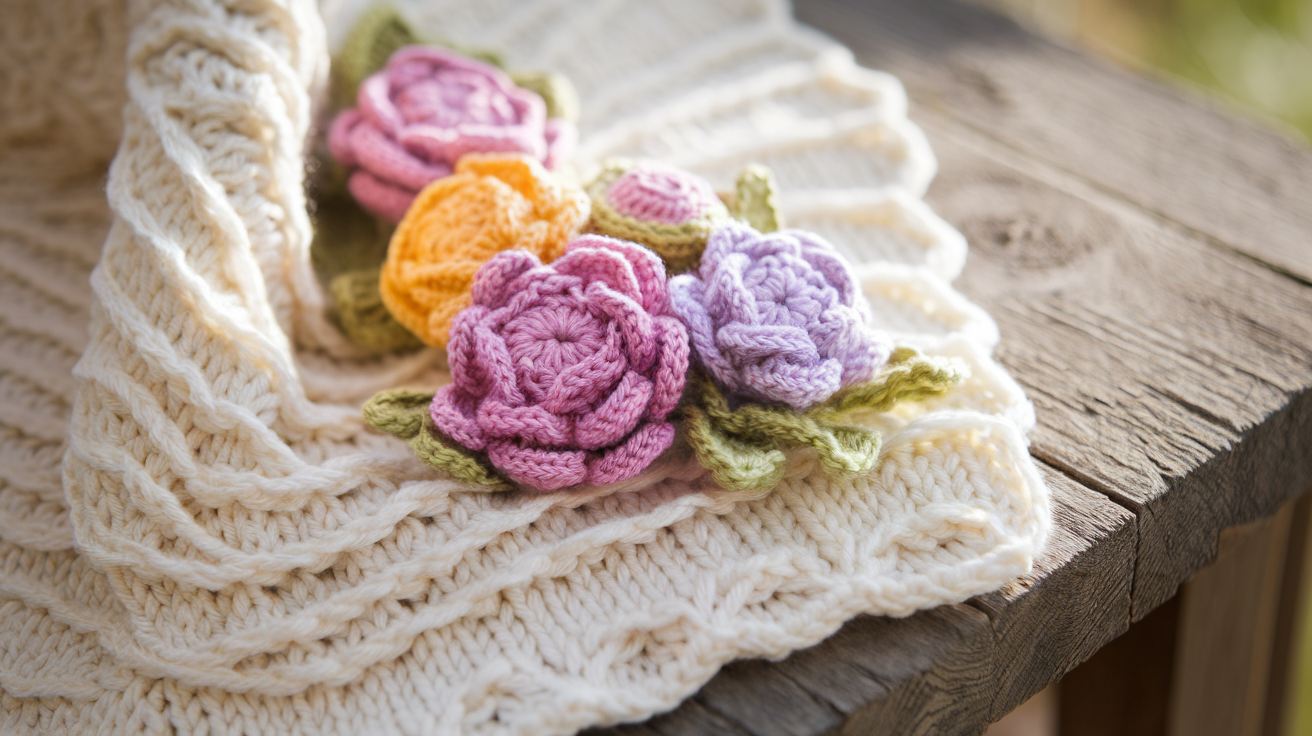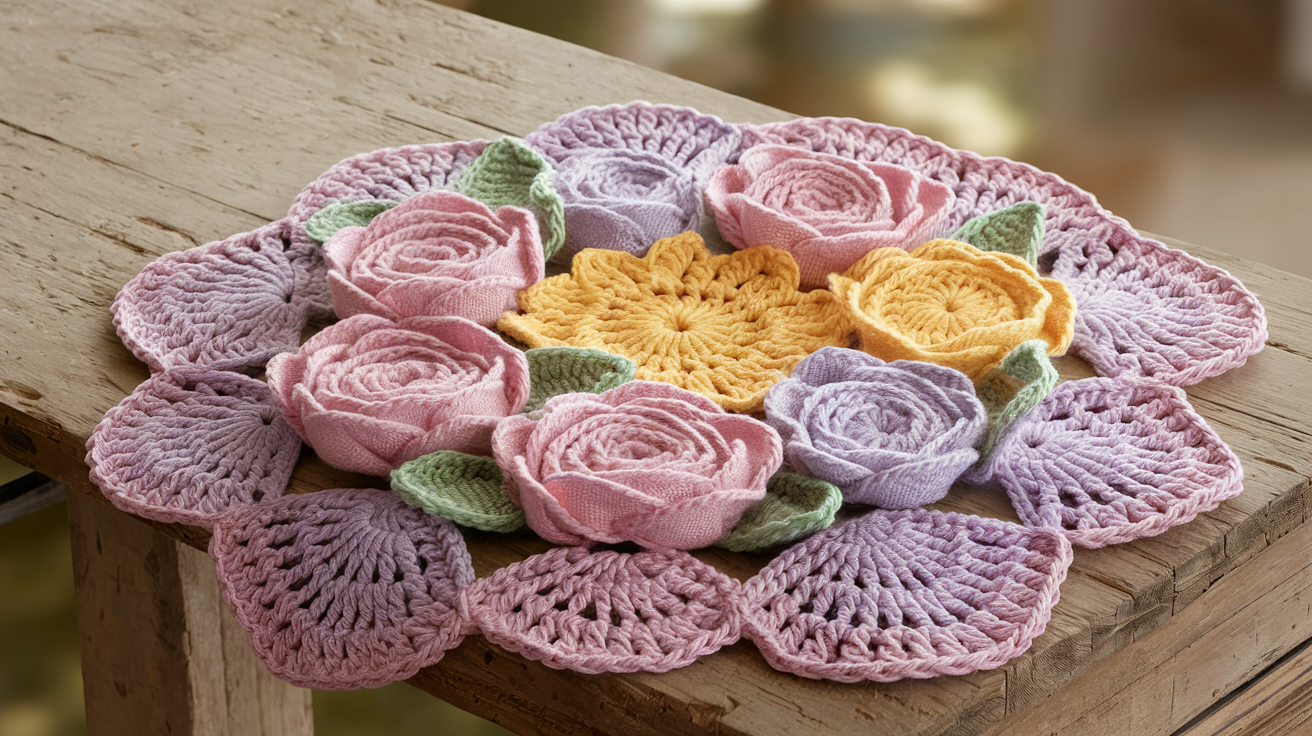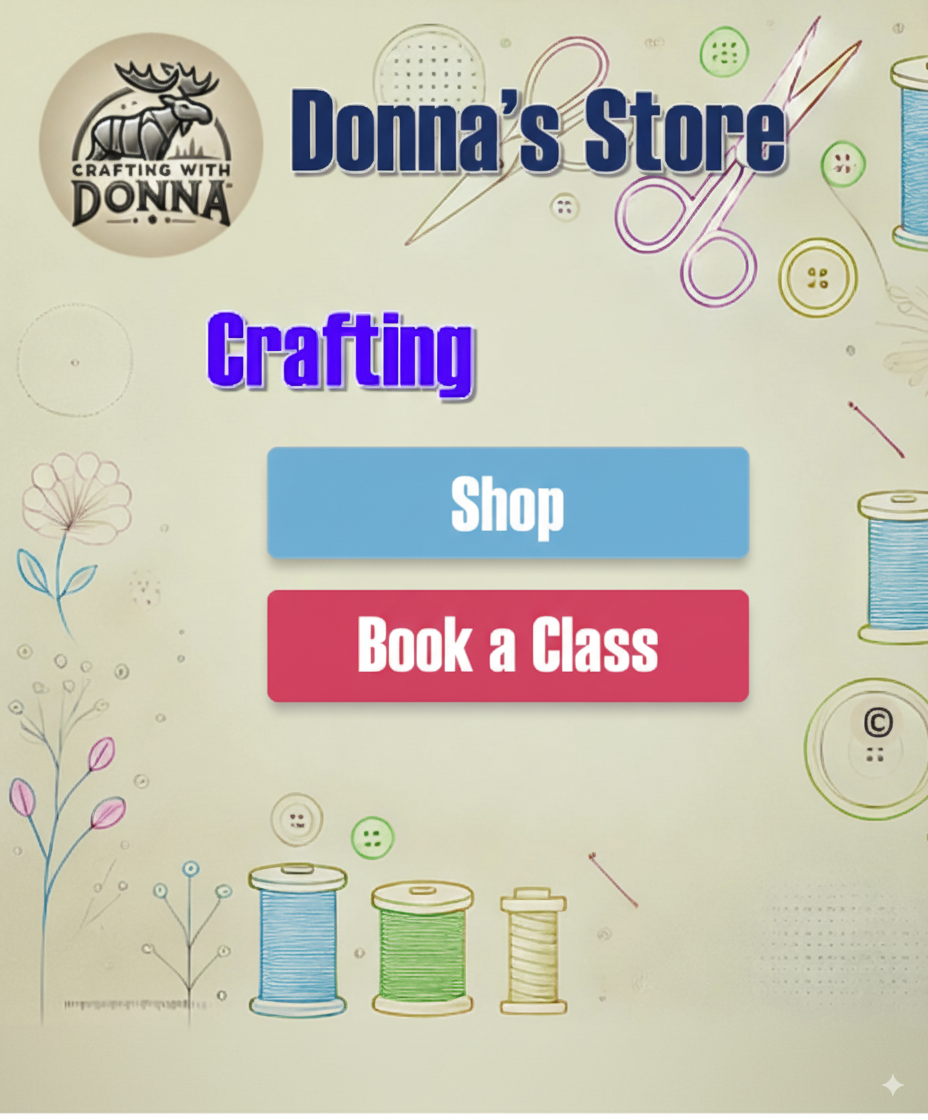How To Embellish Your Knit Dishcloth With Flowers

Knit dishcloths are instantly elevated from everyday household items to memorable handmade gifts when you learn how to embellish your knit dishcloth with flowers using creative craft techniques and colorful yarn. Flower embellishments offer an opportunity for craft project personalization, enabling you to explore different knitting skills and embroidery stitches to create stunning floral designs.
By adding flowers to knitted dishcloths—either as embroidered motifs with a lazy daisy stitch or as separately crafted knitted flowers—you transform plain patterns into decorative knitting masterpieces.
Dishcloth knitting becomes a canvas for expressing your style, making each piece a unique, practical craft ideal for home decor or thoughtful gift ideas.
Transitioning into the next step, let’s gather the yarn crafts essentials you’ll need to get started.
Gathering Your Craft Supplies
Cotton yarn is the top choice for dishcloth knitting, offering absorbency and durability ideal for decorative knit dishcloth ideas or knit flower patterns for dishcloths.
Knitting needles in sizes like US 8 (0 mm) work for worsted weight bases, while smaller needles can be used for creating more intricate, delicate floral motifs. For crafting embroidered flowers, gather essential craft supplies such as:
Essential Embroidery Tools
- Embroidery needles with a large eye and blunt tip
- Sharp embroidery scissors
- Tapestry needle for sewing embellishments
Optional Decorative Additions
Optional decorative elements that add dimension to your floral motifs include:
- Buttons or beads for flower centers
- Contrasting yarn for visual interest and variety
Practical crafts like these benefit from both basic and creative notions—ensuring your dishcloth patterns stand out with vibrant, personalized flair as you move on to creative embellishments.

Simple Knit Dishcloth Patterns
Transforming a knit dishcloth into a unique household item begins with selecting simple textures, which offers endless opportunities for practicing core knitting techniques and preparing for future flower embellishment. Many beginner knitting dishcloth patterns, such as garter stitch or seed stitch, provide both ease and durability, making them perfect for mastering basic stitches and creating a beautiful base for your next craft project.
- Beginner Stitch Patterns: Begin with the classic garter stitch, knitting every row with cotton yarn and US 8 knitting needles for an easy, textured result that lays flat. This foundational knitting basic is perfect for any new craft project.
- Texture Variations: Explore variations like a bordered stockinette or incorporating seed stitch for visual and tactile interest. Utilize yarn scraps to optimize your craft supplies and create beautiful patterned dishcloths.
- Garter Stitch Example: Cast on 28–30 stitches, and knit every row until your knit dishcloth reaches approximately 7 inches. Then, bind off loosely to complete this simple yet functional craft project.
- Gauge Advice: While precise stitch gauge is less critical for dishcloths, swatch a few rows and columns. This allows you to preview your yarn weight and ensure your desired size before commencing your final knitting projects, a key step in dishcloth knitting.
Choosing Your Floral Motifs
Enhancing a dishcloth knitting project with well-chosen floral motifs instantly elevates your handmade decor, infusing the piece with personality and charm. Roses and daisies offer striking or cheerful touches, respectively, while poppies and tulips add bold color or sleek lines. These designs beautifully complement textured backgrounds like garter or moss stitch, adding visual appeal to your decorative knitting.
- Motifs for Texture: Employ embroidery stitches, such as the lazy daisy stitch, for delicate petals. Alternately, attach separately knitted flowers using a tapestry needle and contrasting yarn for playful, creative embellishments to your knitted flowers.
- Palette Selection: Consider harmonious yarn colors inspired by nature, such as green stems with bright blooms. Alternatively, create visual impact with complementary or seasonal designs for your floral designs, adding a unique touch to your gift ideas.
- Visual Appeal: Build upon your knit foundation by scattering or clustering embroidered flowers for balanced composition. This approach links your floral motifs directly to the overall decorative knitting theme, enhancing the aesthetic of your household items.
| Knitting Technique | Yarn Type | Recommended Needles | Floral Embellishment Example |
|---|---|---|---|
| Garter Stitch | Cotton Yarn | US 8 Knitting Needles | Lazy Daisy Stitch |
| Seed Stitch | Yarn Scraps | US 8 Knitting Needles | Separately Knitted Flowers |
| Stockinette Stitch (Bordered) | Contrasting Yarn | US 8 Knitting Needles | Embroidered Flowers |
How to Knit Flowers
Knit dishcloth projects transform into eye-catching household items with delightful flower embellishments, expertly crafted using simple yet effective knitting techniques. Cotton yarn in a spectrum of vibrant hues provides the ideal foundation for creating soft, colorful petals—begin by casting on the necessary stitches and employ basic techniques like yarn overs and decreases to skillfully shape each element.
Crafting petals individually facilitates effortless assembly: utilize a tapestry needle to carefully stitch your petals together through their concluding loops, gently pulling tight to form a full, dimensional bloom.
Contrasting yarn proves exceptionally beautiful for realistic flower centers, while utilizing leftover yarn scraps offers both variety and sustainability for your charming design.
Layering petals or experimenting with different yarn weight introduces captivating dimension, and finishing with small buttons or beads for the centers brings creative embellishments to your craft project, resulting in thoughtful handmade gifts.
Creating Petals with Basic Knitting
Knitting patterns for petals often begin with a few stitches cast onto your knitting needles. Shape each petal using simple increases and decreases to achieve a rounded or pointed form.
Yarn overs and careful decreases are key to creating the natural curves of a bloom, forming the basis for your decorative knitting. This technique is accessible even for beginner knitting enthusiasts looking to add unique touches.
Assembling Multi-Part Flowers
Once your individual petals are knitted, you’ll need a tapestry needle to bring them together.
For easy assembly of knitted flowers, carefully sew your petals through their final loops, pulling the yarn to cinch them neatly.
This creates a full, dimensional bloom, ready for placement on your dishcloth knitting projects.
This method allows for great customization within your knitting projects.
Adding Dimensional Blooms
To create dimensional blooms, consider layering petals strategically. Experimenting with different yarn weight and textures can add further depth to your floral designs.
Small buttons or beads sewn securely to the center of your knitted flower add a polished finish, enhancing the overall visual appeal of your creative embellishments.
Attaching Knitted Flowers Securely
Tapestry needle techniques are fundamental when transferring delicate knitted flowers onto your finished knit dishcloth base, ensuring long-lasting durability and a professional finish. For the most secure attachment, meticulously sew the flower through its base and into the underlying dishcloth stitches, anchoring each motif firmly so it withstands frequent washing and everyday use.
Placement significantly contributes to achieving balanced floral motifs: experiment by scattering blooms artistically or clustering them at the corners for appealing creative embellishments tailored to your specific home decor.
Consider employing the duplicate stitch or various embroidery methods—like the elegant lazy daisy stitch—to seamlessly integrate embroidered flowers alongside your sewn designs.
This approach aligns perfectly with overall craft project goals focused on personalization, guaranteeing your dishcloths are as functional as they are aesthetically pleasing, making them wonderful gift ideas.
Secure Attachment Methods
When attaching your beautiful knitted flowers, using a tapestry needle to sew through the base of the flower and into the existing stitches of the dishcloth knitting ensures a robust connection. This anchors the motif effectively, making it resilient against washing and wear, a key aspect for practical crafts.
Always ensure you are working with suitable sewing needles for a clean finish.
Advising on Placement for Visual Balance
The deliberate placement of your floral designs is key for aesthetic appeal in your knitting projects. Whether you choose to scatter blooms across the surface or create a focal point by clustering them, thoughtful arrangement enhances the visual balance.
Consider how the patterned dishcloths will be utilized and where the embellishments will best showcase your knitting skills.
Suggesting Duplicate Stitch or Sewing
For integrating floral motifs, both the duplicate stitch and careful sewing with a tapestry needle are excellent methods.
The duplicate stitch offers a way to create solid, colorful imagery directly onto the fabric, akin to intarsia knitting.
Sewing separately knitted flowers provides a more tactile, three-dimensional effect. Both techniques contribute distinct charm to your yarn crafts.
Connecting to Embroidery Detail
To enhance your embroidery stitches and add further detail, consider incorporating elements like the lazy daisy stitch.
This works wonderfully for creating leaves or smaller petal accents, complementing your main knitted flowers. Such decorative stitches can add a beautiful layer to your craft customization, bridging the gap between knitting and embroidery for truly unique handmade decor.
Key Techniques and Materials for Knitted Flowers
- Simple knitting techniques such as yarn overs and decreases are used to shape petals, with contrasting yarn ideal for realistic flower centers.
- A tapestry needle is essential for assembling knitted flowers by stitching petals through their concluding loops and for securely attaching them to knit dishcloths.
- Layering petals, experimenting with different yarn weights, and adding embellishments like buttons or beads enhance the dimension and visual appeal of floral designs.
- Secure attachment methods involve sewing through the base of the flower and into the dishcloth stitches, with placement and techniques like the duplicate stitch or lazy daisy stitch contributing to aesthetic balance and integration.
Adding Embroidered Flowers Details
French knots and lazy daisy stitch instantly elevate any knit dishcloth, fusing color, texture, and dimension for a truly vibrant flower embellishment effect. Utilizing embroidery stitches like satin stitch to fill petals or experimenting with fly and fishbone stitches for varied leaves, letting contrasting yarn hues add lifelike interest to each motif.
Pay special attention to stamen—French knots, especially when clustered tightly in the center, create a captivating focal point for embroidered flowers[1][4].
For extra realism, layer stitches with different yarn colors or choose variegated embroidery floss to mimic natural shading.
Before stitching on your dishcloth, practice on a knit swatch to perfect your craft project and ensure your finished design blends seamlessly with existing knitted flower techniques. Creative embellishments, additional decorative possibilities await to complement these stunning floral details.
Creative Embellishments for Dishcloths
Beads and novelty buttons can turn the center of a knit dishcloth blossom into a tactile, visual highlight, while thread painting with embroidery floss invites a painterly touch to both floral and abstract designs.
Incorporate surface design by blending multiple strands of colorful yarn in different thread shades, creating a stunning sense of depth across your dishcloth patterns. For added whimsy, embroider small motifs like ladybugs or butterflies, or try geometric shapes for a contemporary twist.
Expand your craft inspiration by combining several creative embellishments: pair knitted flowers with embroidered centers, or cluster fabric leaves and button flowers for a lush garden scene.
These embellishments ensure your handmade gifts are as unique and expressive as your creativity allows.
Supporting Embellishment Techniques for Knit Dishcloths
- French knots and lazy daisy stitch can add color, texture, and dimension to knit dishcloths for a vibrant flower embellishment effect.
- Satin stitch is recommended for filling petals, while fly and fishbone stitches can be used for varied leaf designs.
- Clustered French knots in the center of embroidered flowers create a captivating focal point.
- Beads, novelty buttons, and thread painting with embroidery floss are suggested for adding tactile and visual highlights or a painterly touch to dishcloth designs.
Why Decorate Your Dishcloths
Starting with the essential role of a knit dishcloth in kitchen routines, this humble household item becomes much more when it receives creative flower embellishments. Cotton yarn patterns not only help tackle spills and chores with practical cotton yarn, but decorative knitting also brings personality and style to your daily tasks.
Adding a flower embellishment with techniques like the lazy daisy stitch instantly upgrades a utilitarian object into a piece of home decor, brightening the kitchen and providing a sense of accomplishment as a small craft project.
Handmade gifts gain special meaning when you embellish a dishcloth, as recipients appreciate the time, creativity, and unique touch involved—perfect for housewarmings or birthdays.
Whether experimenting with new craft techniques or using up yarn scraps, enhancing dishcloths with floral motifs offers a satisfying creative outlet, allowing crafters to personalize, beautify, and gift thoughtful, functional crafts, and cherished items.
Elevating Everyday Items
Exploring various knitting patterns, a simple knit dishcloth becomes a canvas for artistic expression.
The beauty of adding embroidered flowers or separately knit blossoms transforms a basic necessity into a charming piece of functional art. Using a tapestry needle, you can securely attach these creations, ensuring they withstand regular use.
This approach allows for great craft customization, turning a utilitarian object into something truly special.
The Joy of Handmade Gifting
Presenting a decorated dishcloth as DIY gifts imbues them with personal sentiment.
Recipients cherish the effort and artistry poured into these practical crafts, making them ideal personalized gifts. The combination of a useful item and unique decoration makes for memorable gift ideas.
Experimenting with yarn colors and dishcloth patterns allows for a wide range of beautiful floral designs, perfect for any occasion.
A Creative Outlet for All Skill Levels
This craft offers a fantastic way to develop knitting skills and explore new craft techniques.
From beginner knitting to more advanced methods like intarsia knitting, there’s always something new to learn.
Utilizing leftover yarn variety and practicing embroidery stitches like the lazy daisy stitch or duplicate stitch are excellent ways to refine your abilities.
The process of creating patterned dishcloths or adding knitted flowers is a rewarding craft inspiration, especially when working with different yarn weight and knitting needles.
Practicality Meets Aesthetics
The primary function of a knit dishcloth is, of course, utility.
By incorporating creative embellishments, these household items become aesthetically pleasing. Using contrasting yarn for flower centers adds visual depth, while careful attention to stitch gauge ensures a polished finish.
These knitting projects are not only beautiful additions to your own home but also contribute to a more enjoyable daily routine.
- Decorating dishcloths transforms a utilitarian item into a piece of home decor, adding personality and style to daily tasks.
- Embellishing dishcloths with floral motifs provides a satisfying creative outlet and makes for thoughtful, functional handmade gifts.
- This craft allows for customization, enabling crafters to personalize items and experiment with various knitting and embroidery techniques.
- The addition of creative embellishments enhances the aesthetic appeal of dishcloths, making them beautiful additions to a home and contributing to a more enjoyable routine.




